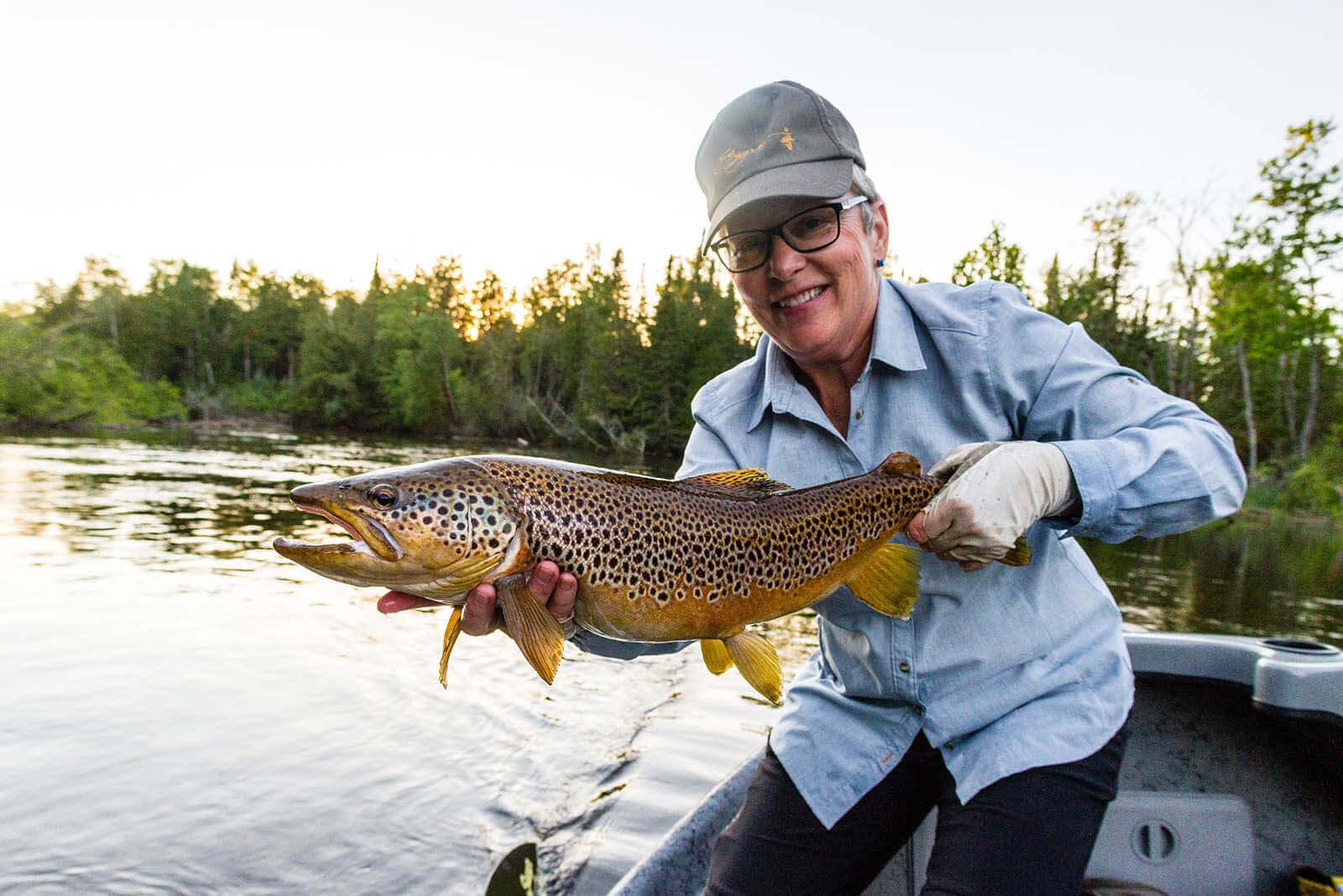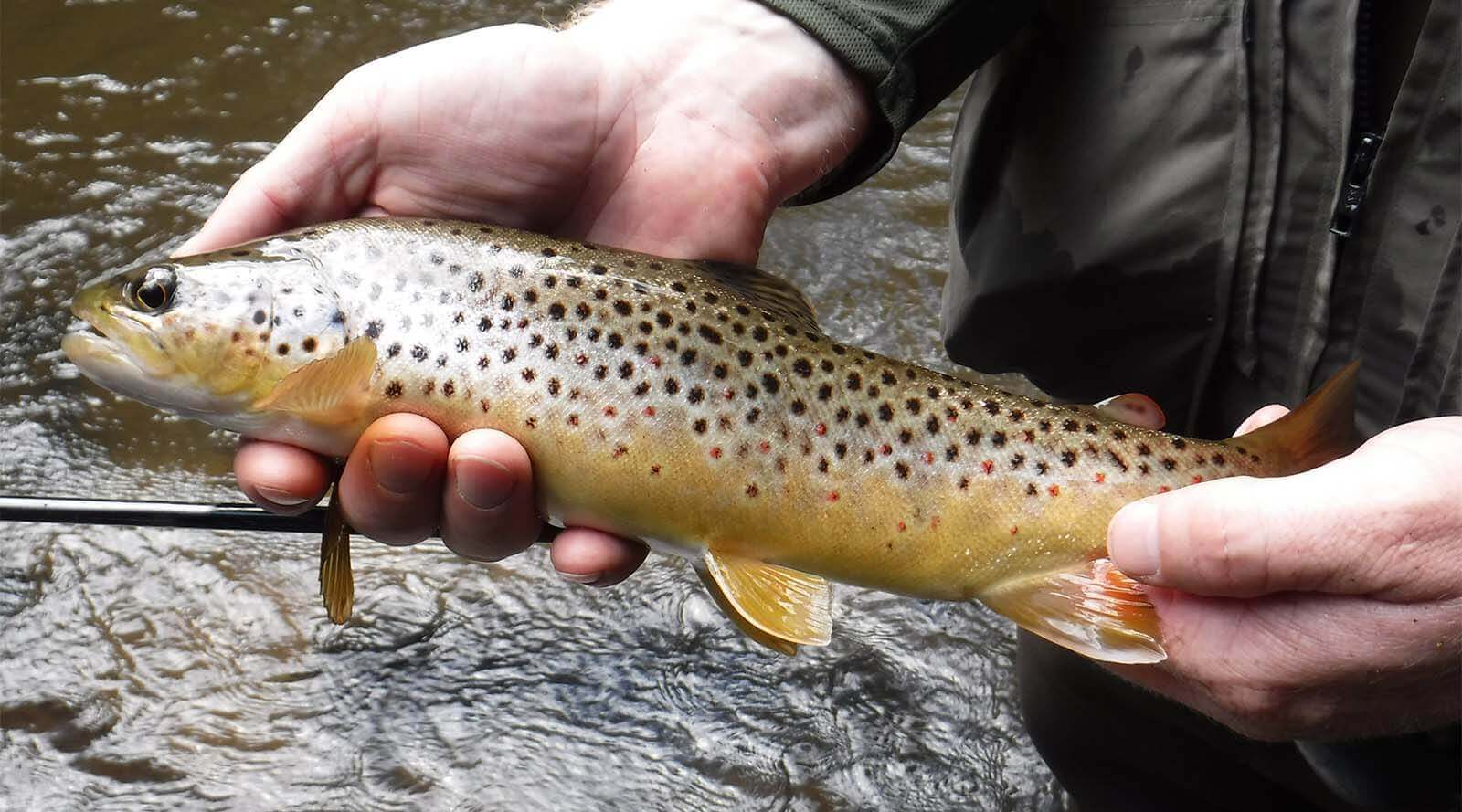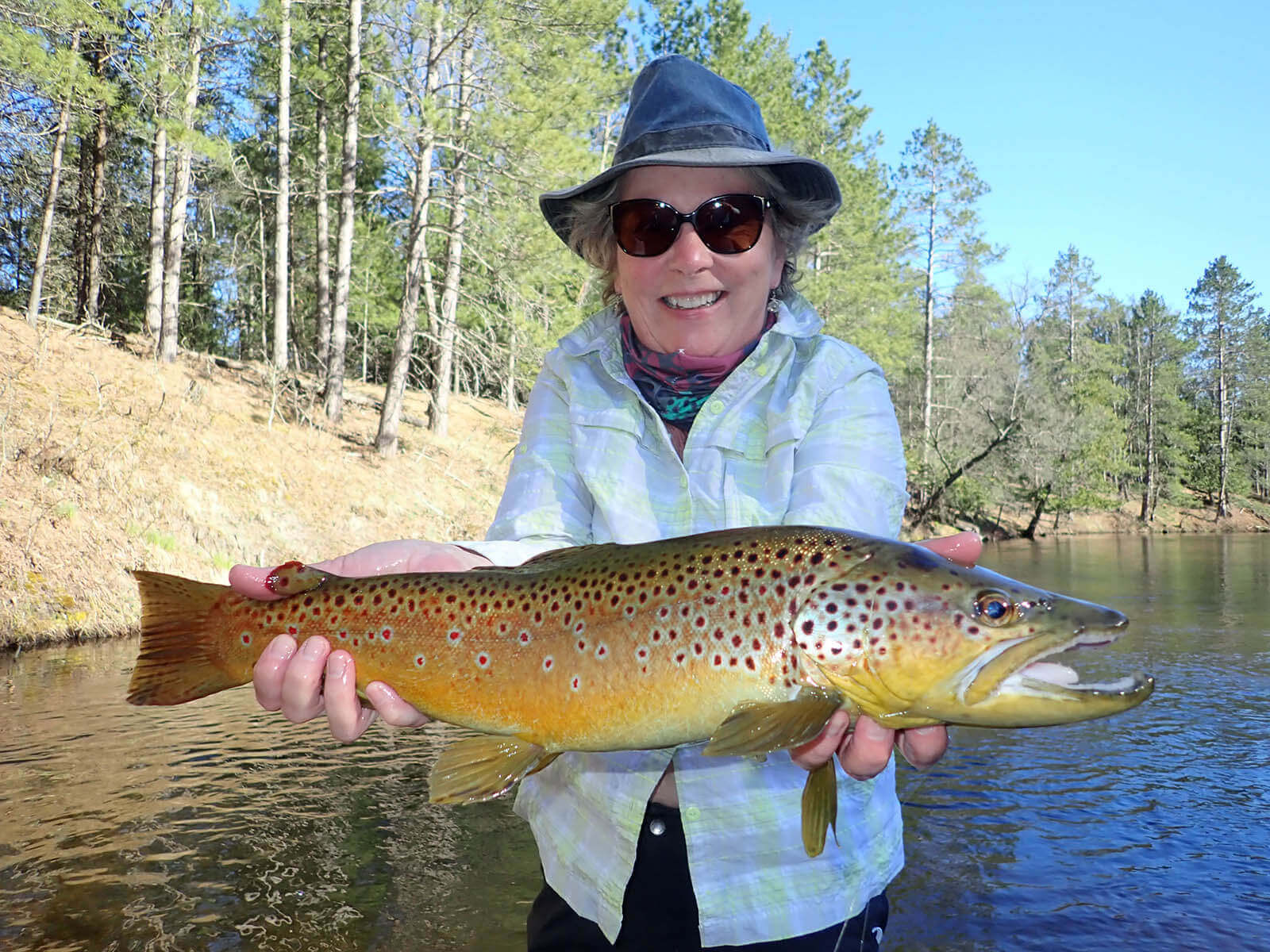Fly Fishing – A Conversation with Angler Ann Miller

Fly fishing in many ways is an art form. Like many arts, the basics can be learned quickly but the refinement and personalization are a lifelong passion that manifests in increasing finesse and elegance. Watching a well-seasoned angler cast can be mesmerizing. The flow of the line and lure through the air, and the way that they lightly and effortlessly land on the water, is beautiful. This lightness leads to a very natural presentation of the lure and is key to the success of this fishing style.
 When I was a teenager, I really wanted to be a fly fisherman. My family, for the most part, used spin casting techniques for fishing, which is also a very effective method. However, fly casting seems so much more romantic, meditative and relaxing. For my birthday one year, I received my first fly rod and was soon spending hours in our yard trying to learn various casting techniques. The process was a bit frustrating because I frequently broke flies off my tippet (the thin line between the fly/lure and a thicker part of the line) due to improper casting. But I kept at it and, eventually, I was able to improve.
When I was a teenager, I really wanted to be a fly fisherman. My family, for the most part, used spin casting techniques for fishing, which is also a very effective method. However, fly casting seems so much more romantic, meditative and relaxing. For my birthday one year, I received my first fly rod and was soon spending hours in our yard trying to learn various casting techniques. The process was a bit frustrating because I frequently broke flies off my tippet (the thin line between the fly/lure and a thicker part of the line) due to improper casting. But I kept at it and, eventually, I was able to improve.
My interest was not only in fishing but fly tying, too. It was such a fun and creative process that I started to spend more time tying flies than fishing. I had boxes full of a wide range of sizes and styles of flies. I got to be good enough that I was even able to sell a few to an area tackle shop. Throughout high school, fishing in various forms and tying flies was my life.
However, when I went to college, I had less time to devote to fishing and eventually I stopped tying flies altogether. That is until years later when I attended a fly fishing/tying event in Benton Harbor by prodigious angler Ann Miller. She was talking about her book Hatch Guide for Upper Midwest Streams. Ann reignited my interest in fly fishing and I cannot think of anyone better to have a Q&A with about the topic.
When did you become interested in fly fishing?
I became interested in fly fishing in graduate school. I was studying aquatic biology and was also taking an entomology (insect) class. I loved to fish, and some colleagues took me out and introduced me to my first river hatch. They gave me some very brief instructions on what to do and then left me in the dark. Once the mayflies began emerging, I became a little too excited and made a mess of my leader and tippet. I didn’t catch anything, but I was definitely hooked on the sport.
What inspired you to start tying your own flies?
I took a fly fishing class with my husband, Ken, at L.L. Bean in Maine. Fly tying was part of the introductory course, and it was really fun. I struggled with it on my own (Ken threw in the towel!), but took another class and then another and got pretty good. Now I spend all winter tying and creating. Online resources have made fly tying instruction very accessible and helpful to tiers of all levels.
How do you select which fly to use?
Fly selection is one of the most important choices in fly fishing. Sometimes fish are extremely selective … they key in on certain insects and even certain stages of a life cycle seasonally. Insect hatches change seasonally and also even within a day. Understanding insect life cycles and hatch times (phenology) helps an angler to make an educated guess as to what bug a fish is eating, which in turn leads to angler success.
What are the optimal conditions for trout fishing?
Early in the spring, insects hatch mid-day, so trout are actively feeding then. As the season progresses, insect hatches move toward the cooler parts of the day — typically morning and evening. A good hatch guide will help an angler to determine the best times to be on the river to try to maximize success. Sunny days are nice for a boat ride but typically not so great for catching fish. Cloudy days, pressure changes and sometimes even a light rain will trigger insect hatches and fish activity.
What is the best way to learn how to cast?
The best tip for learning to cast is to take a lesson. In all sports, we typically have some kind of coaching or private lesson to get better. Fly casting is much different than spin fishing and it can be challenging to get the hang of it by reading a book. Some hands-on casting with an expert will go a long way and prevent bad habits from becoming established (or maybe break bad habits that one might already have).
Are there any casting techniques that work best for rivers in SWMI?
Michigan’s rivers are often very “tight” — meaning they are narrow and brushed covered. The most useful cast for our smaller streams is a roll cast: essentially a technique that propels the line forward away from the angler without catching the fly in the brush behind. On wider rivers, one can cast using a traditional backcast and forward cast, especially if casting from a boat.
Do you have any tips for safely catching and releasing?
I like to fish with a barbless hook which helps for easy removal. I carry hemostats that allow me to flip the hook out often without even touching the fish. I try to keep the fish in the water as much as possible to minimize stress. If I do handle a fish, I make sure my hands are wet so that I don’t inadvertently remove the slime coat from their skin which helps to protect them from disease. If I am going to take a picture, I try to get the fish in and out of the water quickly; a friend taught me to hold my breath as long as the fish was out of the water to remind me that the fish was not breathing either.
Where do you suggest beginners fly fish?
I encourage beginners to start out fly fishing for bluegills. They are often not as picky about taking a fly as compared to a trout. Casting is generally on a lake with fewer hazards for interfering with your backcast. Quite often, you can watch the bluegill eat the fly and then turn, which is the key to the angler to set the hook — good habits to pick up before graduating to trout fishing. There are plenty of trout streams in Michigan: start with a river that you feel like you can safely wade. Almost all rivers have sections with shallower waters where you can gain confidence. It’s also a good idea to hire a fly fishing guide. You can fish with a friend or alone, for a half or an entire day. A good guide will work with a beginner, helping with casting, knot-tying, fly selection, etc.
Other than trout, what do you like to fish for?
I love trout fishing because they live in beautiful places. Wandering thigh-deep in a river allows me to completely forget about everyday stresses. But a lake or pond also provides an escape. Bluegill, bass, and pike are all great fun to catch — bluegill are especially fun on a fly rod. Here in Southwest Michigan, we also have the opportunity to fish for steelhead and salmon. Occasionally, I am fortunate to escape in the winter months for some saltwater fly fishing, hunting species such as bonefish, tarpon and permit.
What etiquette should beginners know about?
There are plenty of etiquette rules and chapters written about them. The best advice is to ask questions when encountering another angler. “I don’t want to fish your water, but I would like to move around you. Are you fishing upstream or downstream?” An angler sitting on the bank or a log is likely waiting for a hatch to start or may be ‘resting’ a fish. Be careful not to frighten another angler, especially in the evening or at night. Again, some polite conversation like “I’m moving around you on the bank,” will prevent any potential ‘rod rage’ on the water.
What equipment should a beginner bring with them when out fishing?
Being completely outfitted for fly fishing is a bit of an investment, not unlike other sports. Rod, reel, line, tippet and flies are the basics. Waders are nice to have and they allow you to be more comfortable in the water. Polarized sunglasses are essential as they allow you to see into the water and thus see any obstacles on the river bottom like rocks and logs that you might otherwise trip on. They will also protect your eyes from a bad cast … it’s all fun and games until a hook lands in or near your eye and a trip to the emergency room ensues. A hat will protect you from the sun and from biting insects as well as from the occasional bad cast. Hemostats are very useful for removing a fly from the fish’s mouth. Some anglers carry their gear in a vest while others, including myself, prefer a sling pack which takes a lot of weight off the shoulders.
Is there anything else you would like to mention?
Fly fishing is such an enjoyable sport, hobby or pastime — however, you prefer to think of it. Every time I go to the river, I learn something new. I might see a new bird or mammal, run into an old friend, encounter an unfamiliar hatch or catch a fish that I’ve hooked and released the year before. I enjoy catching “challenging” fish, meaning fish in a tough spot or eating something that might take me a while to figure out. I’m often humbled by the river … being outsmarted by a fish with a tiny brain used to bother me, but I’ve learned that I don’t know everything — not by a long shot. People come to fly fishing at all ages of life. It’s never too late to learn.
Ann’s Bio:
Ann Miller has been fishing her entire life and can now say that she has been exclusively fly fishing for more than half that time. A life member of Fly Fishers International and Trout Unlimited, she decided to become more active in the Great Lakes Council of the FFI over 20 years ago, becoming editor of the now-defunct newsletter, The Leader. Editing quickly led to writing and, before long, she was penning essays for other publications.
While teaching beginning and intermediate fly fishing schools, she became frustrated with the lack of comprehensive Midwest information on insect hatches, taxonomy, behavior and flies to match them. An aquatic biologist, she decided to tackle the world of bugs head-on, and the result is the Hatch Guide for Upper Midwest Streams. The field guide was published in January 2012, by Frank Amato Publications. The guide is now out of print but will be republished in a new format in 2021.
In addition to writing, Ann is a founder and the current president of Flygirls, an organization whose purpose is to help women become involved in fly fishing. The club was founded in 1996 and continues in its purpose to teach women to fly fish as well as provide fly fishing and fly tying outings in Michigan and beyond. Ann is also a long-time member and current vice president of the St. Joseph River Valley Fly Fishers of South Bend, Ind.. She and her husband Ken Ankli live in Benton Harbor.
Share with Us
Please send us photos and videos of your Southwest Michigan getaway. Use our hashtag #swmichigan or upload your photos to our content collector below. This is an opportunity for your photos to appear on our social media, website or marketing materials. Thanks for sharing your memories!
